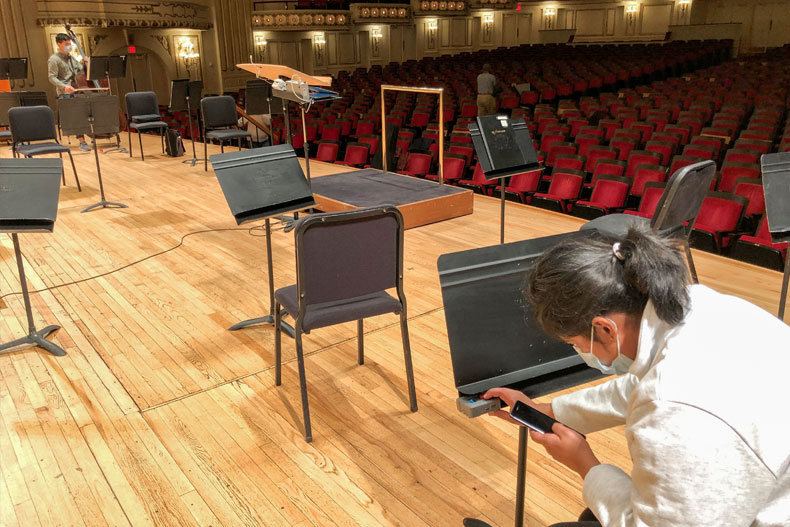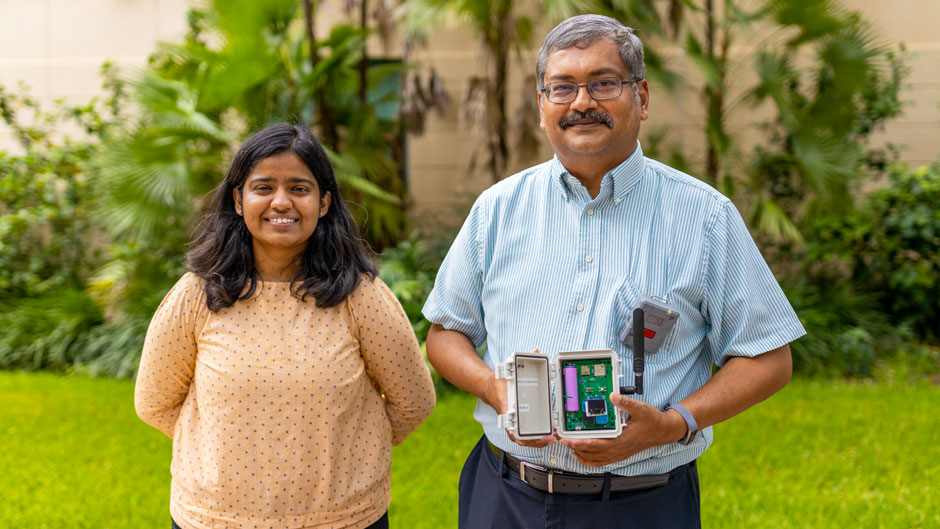In the not-so-distant-future, Pratim Biswas envisions a time when people can measure their risk of catching COVID-19 in all sorts of environments—like restaurants, doctor’s offices, and hospitals—by simply wearing a small air quality sensor and connecting it to an application on their phone.
Biswas, a veteran aerosol scientist who is dean of the University of Miami College of Engineering, has been refining these sensors for years, with the original goal of monitoring air quality for industrial workers in different settings. But when COVID-19 came along, it provided an even more pertinent avenue for the devices, which absorb air from a small box that can be worn or a larger one placed on the wall.
“Air quality sensors are a pretty new field, and we are one of the pioneers of using them for COVID-19 detection,” Biswas said, adding that two of his former graduate students even formed a company, Applied Particle Technology, to mass produce the wearable sensors before the pandemic. “The MAXIMA device is a somewhat larger unit and is placed on a surface such as the wall and the MINIMA is the wearable sensor, and they can exchange data with each other as well as with a dashboard.”
Yet, as the world began to focus on the COVID-19 pandemic in early 2020, Biswas’s aerosol research shifted, too. He is now working on several projects that reveal how SARS-CoV-2—the virus that causes COVID-19—spreads through the air and how engineers can help people to reduce their chances of contracting the illness. While the sensors currently measure all airborne particles in real time, Biswas wants to integrate them with technology that could indicate whether the particles contain active viruses.
“In the future, these sensors could even be applicable to the flu and other viruses, which may be less severe but are still important to monitor,” he said. “And if there’s an increase in virus concentration levels, the sensor could set off a warning.”
In fact, Biswas and one of his Ph.D. students, Sukrant Dhawan, even published a paper outlining how SARS-CoV-2 virus can travel through the air in droplets. In it, they explained that some of the smallest particles can linger in the air for hours after an infected person talks, coughs, sneezes, or breathes and that some particles can travel more than 6 feet from an infected person. Biswas and Dhawan also crafted their own computer model that can compute a person’s risk of being infected from someone standing in front of them with COVID-19, based on the circumstances of the uninfected individual.
Biswas and his team at the Aerosol and Air Quality Laboratory—previously based at Washington University in St. Louis, and now located at the University of Miami—are also looking at the effectiveness of different COVID-19 prevention strategies, such as masks and ventilation systems to help lower the risk of indoor transmission. In another study, they measured the efficacy of several types of masks and found that the N95 and KN95 masks are ideal, but if people do not have access to these, it is important to use some type of mask, Biswas said.

The researchers also wanted to measure the risk of being infected with COVID-19 in places like a hospital waiting room, an orchestra hall, and a dental office. Therefore, Biswas’ team, including Shruti Choudhary, a doctoral student in chemical, environmental, and materials engineering, set up their MAXIMA and wearable MINIMA sensors in a variety of locations in the St. Louis region. They then created heat maps showing where the highest levels of aerosols were located.
Although they are still analyzing the data, early indications reveal that the air in hospital waiting rooms with adequate ventilation was relatively clean, whereas dental offices and orchestra halls had more hot spots, or locations of higher particle concentrations, with the potential for more COVID-19 transmission. Based on these measurements, they also found solutions to minimize the level of airborne particle concentrations in orchestra halls.
“You can create a certain ventilation pattern to clean the area where the aerosols are building up,” Biswas explained. “In the case of the orchestra, the facility could direct the ventilation system to suck out the air from the area of heavily emitted aerosol concentrations at a higher rate.”
Meanwhile, in dental offices, they learned that ventilation and masking are also critical, and they also realized that certain procedures may put the dentist and staff at a higher risk. Therefore, Biswas’ team suggested certain strategies for those procedures, such as using suction tools more often to protect both the dentist and any dental workers in close contact with patients.
“This was the first study of its kind to deploy real-time instrumentation to precisely map out the airborne concentrations of particulate matter in these environments,” Biswas noted.
Meanwhile, Biswas said that he hopes that once they are refined, the MINIMA and MAXIMA sensors will be able to track COVID-19 for businesses and individual consumers. And the more sensors that are deployed, Biswas added, the more accurately they can predict potential risks from the spread of disease.
“The sensors could give information in real time, and if there were a network of them throughout the community, an application could take that data and alert people to take extra precautions if there’s a high level of virus particles near them,” he said.

